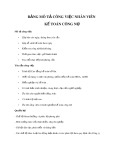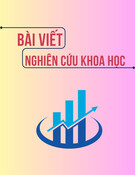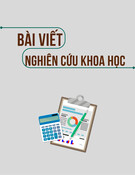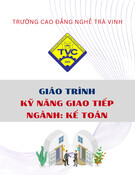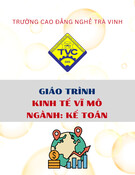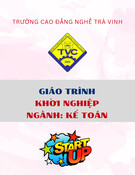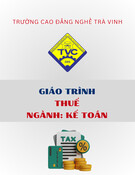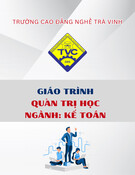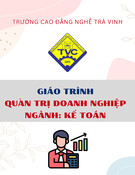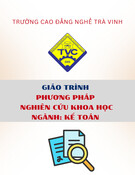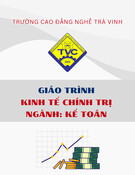
REVISION
ENGLISH FOR ACCOUNTING (ULSA)
Section 1 (10)(1point): Choose the best word to fill in each gap:
1. Nonprofit organizations are in business for some
purposes other than … money.
A. To make
B. Make
C. Making
D. Made
2. Private accountants, also called executive or
administrative accountants, handle the … of a
business.
A. Balance sheets
B. Cash flow statements
C. Profit and los account
D. Financial records
3. Many people have chosen … as a profession
because of its many advangtage.
A. Account
B. Accountancy
C. Accountant
D. Accounting
4. Workers and potential … need financial
information to make decisions about the viability
of entities as employers.
A. Employment
B. Employers
C. Employees
D. Employed
5. Most people who wish to become CPAs now
take university courses in … and related subjects
in order to be as fully prepared as possible for
the centification examinations.
A. Auditing
B. Bookkeeping
C. Engineering
D. Accounting
6. For both internal and … reporting purposes, it is
important to understand the concepts presented
below bacause they serve as a guideline to the
analysis of financial reporting issues.
A. Inside
B. Outdoor
C. Outside
D. Enternal
7. The historical cost principle deals with the
valuation of both … and liabilities.
A. Capital
B. Assets
C. Loans
11. A balance sheet shows the financial … that a
company has at a point in time and where they
came from.
A. Records
B. Resources
C. Returns
D. Revenues
12. It is an instant photograph that displays the
company’s financial ... at the end of a business
month, quarter or year.
A. explanation
B. position
C. publication
D. station
13. The organization of a balance sheet reflects this
basic … assets equal dabts plus equity.
A. Arrangement
B. Assessment
C. Equation
D. Question
14. The … of accounts is a listing of the accounts that
are reflecred in financial statements.
A. Book
B. Chart
C. Table
D. Outline
15. Assets are often listed in the order of their … -
which means how easy it would be to convert
each asset into cash.
A. Complexity
B. Liquidity
C. Security
D. Simplicity
16. Assets are divided into three categoties: Current
Assets, Fixed Assets and … Assets.
A. Current fixed
B. Different
C. Fixed current
D. Other
17. Current assets will likely be turned into cash or
converted into a (n) … within a year.
A. Bonus
B. Expense
C. Option
D. Stock

D. Revenue
8. Every country has its own standard accounting
practice of GAAP with standards … by a
national governing body (National GAAP).
A. Recorded
B. Reported
C. Set
D. Announced
9. With the … of global standards, fair value is
used more in the United States to value elements
of financial statements.
A. Convergence
B. Combination
C. Develop
D. Impact
10. Asset ledger commonly has entries that bolster
the company’s financial strength but, if an
asset .. in value, depreciation also is recorded.
A. Decreases
B. Increases
C. Lost
D. Gain
18. Fixed assets are saleable, but are not expected to
be converted to cash in the … course of business.
A. Average
B. Equal
C. Final
D. Normal
19. Liabilities are debts or … stemming from goods
or services received byh the company.
A. Obligations
B. Others
C. Outstandings
D. Owed
20. If the assets of a company are greater than its
liabilities, then the equity of the business is the
positive … between the two numbers.
A. Caculation
B. Difference
C. Dividend
D. Sum
Section 2 (5)(1 point): Choose the best term to match the given definition:
1. Money in the form of coins, notes or bills is
called. (Ti n n m d ng ti n xu, ti n gi y ề ằ ở ạ ề ề ấ
hay hóa đn thì đc g i là?)ơ ượ ọ
A. Cheque
B. Asset
C. Cash (ti n m t)ề ặ
D. Capital
2. The money for business activities that a
company obtains by selling share rather than
from loans. (Đây là ti n t ho t đng kinh ề ừ ạ ộ
doanh công ty ki m đc b ng vi c bán c ế ượ ằ ệ ổ
phi u ch không ph i đi vay)ế ứ ả
A. Income
B. Interest
C. Loan
D. Equity (v n ch s h u)ố ủ ở ữ
3. An amount that is written in a company’s
account to show a decrease in the money the
company owes. (Đây là s ti n đc vi t trong ố ề ượ ế
tài kho n c a m t công ty, cho th y công ty b ả ủ ộ ấ ị
gi m s ti n đang s h u)ả ố ề ở ữ
A. Loss (l )ỗ
B. Profit (lãi – l i nhu n)ợ ậ
C. Debit (n )ợ
D. Credit (có)
4. An accounting record where all business
transaction are initial entered. (Đây là m t s ộ ổ
sách k toán ghi l i bút toán đu tiên)ế ạ ầ
13. A reduction in the price which is offered to
customers. (Gi m giá đc cung c p cho 1 kháchả ượ ấ
hàng.)
A. Discount (chi t kh u)ế ấ
B. Decrease
C. Increase
D. Sale
14. Companies make this when they sell their goods
for more than it costs them to make them. (Công
ty s thu đc cái này khi bán hàng hóa v i s ẽ ượ ớ ố
ti n cao h n chi phí mà h b ra)ề ơ ọ ỏ
A. Profit
B. Benefit
C. Return
D. Loss
15. An accounting document for a company that only
contains details about assets, rather than a general
ledger that records all financial aspects of the
company.(M t tài li u k toán trong đó ch ghi ộ ệ ế ỉ
tài s n thôi ch không ghi cái khác)ả ứ
A. Creditors ledger
B. Debtor ledger
C. Asset ledger
D. Liabilities ledger
16. This is the name for buildings, machinery, money
in the bank and money owed by customers. (Đây
là tên cho nhà x ng, máy móc, ti n trong ngân ưở ề
hàng, ti n n khách hàng)ề ợ

A. Journal (nh t ký)ậ
B. Book
C. Record
D. Ledger (s cái)ổ
5. … summary of a person’s or a company’s
financial condition at a specificpoint in time, …
into account their assets. Liabilities, etc. (Đây là
m t b n t ng h p chi ti t v tình hình tài chínhộ ả ổ ợ ế ề
c a m t công ty, nó cho bi t các tài s n, các ủ ộ ế ả
kho n n ,…)ả ợ
A. Profit and loss account
B. Balance sheet
C. Cash flow
D. Shareholder’s equity
6. An official examination of the accounts. (Đây là
m t vi c ki m tra chính th c xem các tài ộ ệ ể ứ
kho n có gian l n không)ả ậ
A. Check
B. Audit
C. Test
D. Investigation
7. An additional journal entry, used correct an
incorrect journal entry. (Đây là m t bút toán ộ
thêm vào đ s a bút toán đã b nh p sai trong ể ử ị ậ
s nh t ký)ổ ậ
A. Final entry
B. First entry
C. Double entry
D. Correcting entry
8. A list of all the accoount names and their current
balance. (Đây là danh sách tên các tài kho n và ả
s d c a chúng) ố ư ủ
A. Balance sheet
B. Credit balance
C. Debit balance
D. Trial balance (b ng cân đi ki m tra – b ngả ố ể ả
cân đi th )ố ử
9. In accounting, it is the engding amount found on
the right side of a general ledger account or
subsidiary ledger account. (Trong k toán, đây ế
là con s n m cu i cùng góc bên ph i c a ố ằ ở ố ả ủ
m t tài kho n s cái)ộ ả ổ
A. Journal balance
B. Ledger balance
C. Debit balance
D. Credit balance (s d bên có)ố ư
10. Selling of goods in large quantities to
shopkeepers for resale to the public. (Bán m t ộ
l ng l n hàng hóa cho c a hàng đ h bán ượ ớ ử ể ọ
l i)ạ
A. Retail (bán l )ẻ
B. Wholesale
C. Purchase
A. Asset
B. Liabilitiy
C. Money
D. Capital
17. The total sum of money which is supplied by the
owners of a company to set it up. (Đây là t ng s ổ ố
ti n đc cung c p b i ch doanh nghi p đ ề ượ ấ ở ủ ệ ể
thành l p công ty)ậ
A. Asset
B. Liability
C. Money
D. Capital
18. These are bought by people wishing to invest in
the company. (Đây là cái ng i ta mua khi ng i ườ ườ
ta mu n đu t vào m t công ty nào đó)ố ầ ư ộ
A. Loans
B. Shares
C. Goods
D. Drawings
19. The extra money a company or person pays for
borrowing money. (Đây là s ti n 1 công ty ph i ố ề ả
tr khi h vay ti n)ả ọ ề
A. Goodwill
B. Loan
C. Interest (ti n lãi)ề
D. Capital
20. Money remaining after all expenses and taxes
have been paid. (Đây là s ti n còn l i sai khi trố ề ạ ừ
đi các kho n chi phí và n p thu )ả ộ ế
A. Interest
B. Profit
C. Net profit (l i nhu n ròng)ợ ậ
D. Cash
21. The balance of cash receipts minus cash payments
over a given period of time. (S d các kho n thuố ư ả
ti n m t tr đi kho n h ch toán - thanh toán ề ặ ừ ả ạ
b ng ti n m t trong m t kho ng th i gian nh t ằ ề ặ ộ ả ờ ấ
đnh, t c là l y tài s n tr đi các kho n n .)ị ứ ấ ả ừ ả ợ
A. Cash flow
B. Balance sheet
C. Equity
D. Budget
22. A list of all employees and their wages.( Danh
sách t t c nhân viên và ti n l ng c a h .)ấ ả ề ươ ủ ọ
A. Salary
B. Staff
C. Assets
D. Payroll (b ng l ng)ả ươ
23. An accounting record where all business
transaction are initially entered. ( Biên b n k ả ế
toán n i t t c giao d ch kinh doanh l n đu ơ ấ ả ị ầ ầ
đc ghi.)ượ
A. Ledger

D. Sell
11. To make something known in public. (Đ làm ể
cho cái gì đó đc công khai.)ượ
A. Know
B. Close
C. Disclose (ti t l )ế ộ
D. Understand
12. Additional piece of information at the bottom of
a page in a book. (Ph n thông tin b sung ầ ổ ở
cu i trang trong m t cu n sách.)ố ộ ố
A. Page
B. Ledger sheet
C. Folio
D. Footnote (chú thích)
B. Journal
C. Balance sheet
D. Accounts
24. Money that is spent to purchase goods or services
provided by someone else.( Ti n dành đ mua ề ể
hàng hoá ho c d ch v do ng i khác cung c p.)ặ ị ụ ườ ấ
A. Loss
B. Gain
C. Expense
D. Receipt
Section 3 (2.5 point): Complete the following sentences with the correct form of the words
in parentheses:
1. When a specified time period is up, these … (lose) and gains are analyzed according to a pre-defined format.
Losses
2. Stockholders want some indication of the potential for return on their … (invest)
Investment
3. There are many parties – owners, creditors, government and … (employ), etc, who are interested in knowing
the results of the firm.
Employes
4. In the United States, the dollar is the unit of … (measure) for all transactions. No adjustment is made for
changes in the purchasing power of the dollar.
Measurement
5. Revenue is realized when goods or services are exchanged, is realizable when assets … (receive) can be
converted to cash and is earned.
Received
6. The standards make it more difficult for organizations to misdrect … (observe) and to fool them with data that
does not have sufficient relevancy.
Observers
7. Ledger is an account book for recording and totaling … (money) transactions by accounts with debits and
credits in separate columns.
Monetary
8. The ledger accoount is prepared under the double-entry system, it helps to prepare a trial balance that provides
a check on the arithmetical … (accurate) of the recording transaction in the books of account.
Accurracy

9. The purpose of journalisation is to record the change in the accounting equation caused by a business event.
Ledger accounts … (category) these changes or debits and credits into specific accounts, so management can
have useful information for budgeting and performance purposes.
Categoriza
10. Nearly all customers have a debit card allowing them to make … (withdraw) and do their transactions at cash
dispeners.
Withdral
11. Banks are specialists in the business of providing capital and in … (allocation) funds on credit.
Allocating
12. The bank is a reservoir of … (loan) money, with streams of money flowing in and out. For this reason,
economists and financiers often talk of money being liquid.
Loanable
13. To open an account, the … (apply) is required to fill in an account opening application form and to deposit
some money.
Applicant
14. Banks often cooperate with governments in efforts to … (stable) ecconomies and prevent inflation.
Stabilize
15. Private accountants handle the financial records of a business. Like those who work for the government or
nonprofit organizations, they are … (salary) rather than paid a fee.
Salaried
16. The chief … (account) officer of a company is the controller, or comptroller, as he … sometimes called.
Accounting
17. Controllers are … (responsibility) for maintaining the records of the company’s operation.
Responsible
18. On the basis of the data that have been recorded, the controllers measure the company’s … (perform); they
interpret the results of the operations, and they plan and recommend future action.
performance
19. Indeed, a controller is often just a step away from being the executive … (office) of a corporation.
Officel
20. Managerial … (account) are other specialists within the broad area of private accounting.
Accounts
21. In particular, they work with the kind of … (finance) reports necessary to management for the efficient
operation of the company.
Financial
22. Many people have … (choose) accounting as a profession because its many advantages.
Chosen

